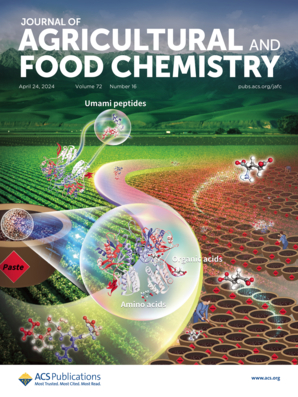提高矮芽孢杆菌热稳定性的工程漆酶及其与水解多糖单加氧酶的结合。
IF 5.7
1区 农林科学
Q1 AGRICULTURE, MULTIDISCIPLINARY
引用次数: 0
摘要
从芽孢杆菌中提取的漆酶被广泛用于木质素解聚。然而,野生型漆酶通常缺乏耐热性,其催化过程通常伴随着木质素的再聚合,限制了其应用。本研究对短小芽孢杆菌漆酶进行了位点饱和突变,得到的突变体A347H和N368L的活性分别提高了2.37倍和2.46倍。这些突变体在80°C和90°C下2小时后都保持活性。上述特性使它们能够在没有介质的情况下有效地催化天然木质素解聚。然后,添加水解多糖单加氧酶(LPMO)和抗坏血酸进一步改善碱木质素解聚,解聚率达到40.87%。对产物结构和反应过程的分析表明,碱解聚是通过增强β-O-4键和c1 - c - α键的断裂,抑制木质素再聚合来实现的。这种漆酶- lpmo偶联体系为木质素的高效加工提供了一种新的策略。本文章由计算机程序翻译,如有差异,请以英文原文为准。
Engineering Laccase from Bacillus pumilus for Improved Thermostability and Its Combination with Lytic Polysaccharide Monooxygenase for Lignin Depolymerization.
Laccase from Bacillus is widely used to improve lignin depolymerization. However, wild-type laccase usually lacks heat resistance, and its catalytic process is usually accompanied by the repolymerization of lignin, limiting its application. Herein, we performed site-saturation mutation on Bacillus pumilus laccase, generating mutants A347H and N368L with activities increased by 2.37-fold and 2.46-fold, respectively. These mutants remain active at both 80 and 90 °C after 2 h. The above properties allowed them to efficiently catalyze native lignin depolymerization without mediators. Then, adding lytic polysaccharide monooxygenase (LPMO) and ascorbic acid further improved alkali lignin depolymerization, achieving a 40.87% depolymerization ratio. The insight into the product structure and reaction process suggested that the enhanced alkali lignin depolymerization was achieved by enhancing the cleavage of β-O-4 bond and C1-Cα bond, as well as inhibiting lignin repolymerization. This laccase-LPMO coupling system presents a new strategy for high-efficiency processing of lignin.
求助全文
通过发布文献求助,成功后即可免费获取论文全文。
去求助
来源期刊
CiteScore
9.90
自引率
8.20%
发文量
1375
审稿时长
2.3 months
期刊介绍:
The Journal of Agricultural and Food Chemistry publishes high-quality, cutting edge original research representing complete studies and research advances dealing with the chemistry and biochemistry of agriculture and food. The Journal also encourages papers with chemistry and/or biochemistry as a major component combined with biological/sensory/nutritional/toxicological evaluation related to agriculture and/or food.

 求助内容:
求助内容: 应助结果提醒方式:
应助结果提醒方式:


